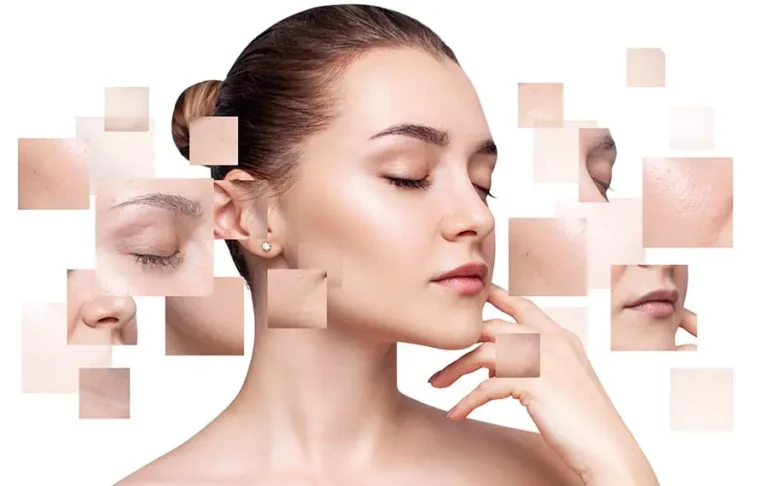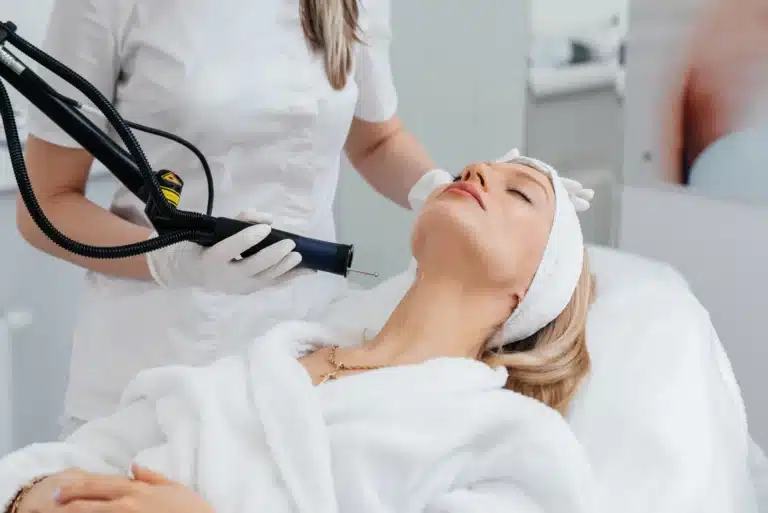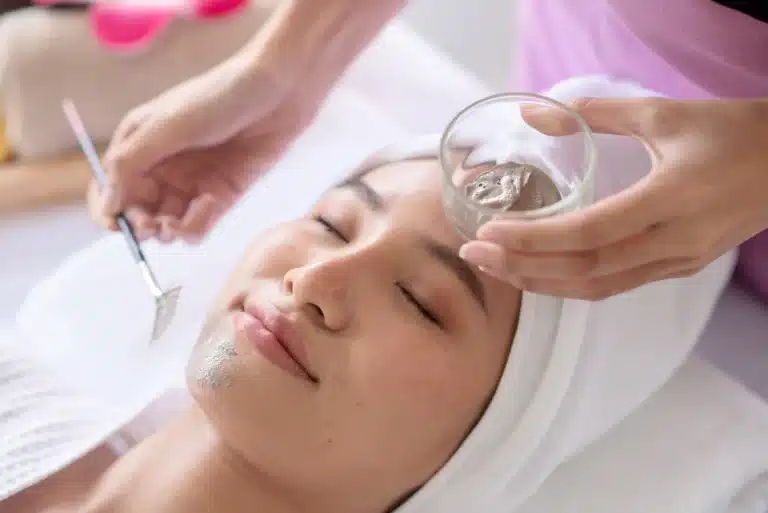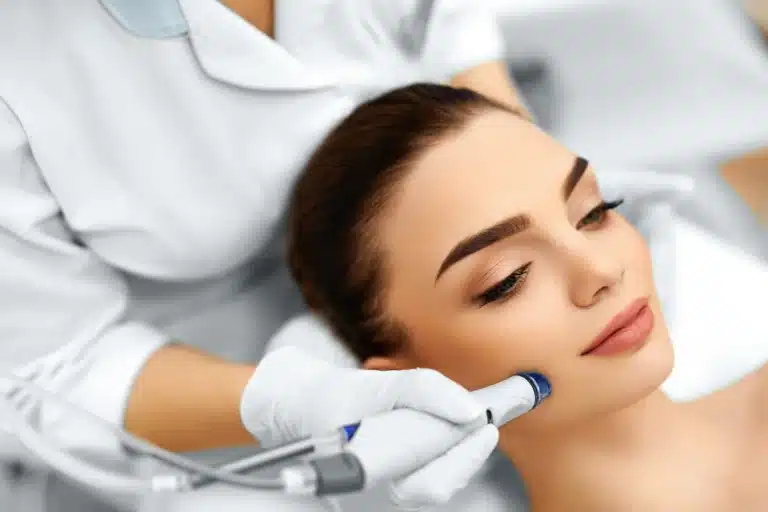Home » Conditions » Skin & hair » Freckles
Freckles, also known as ephelides, are small pigmented spots ranging from 1 to 5 mm, and their coalescence can form larger patches.
Present on sun-exposed areas, these small macules appear during childhood and adolescence. The mucous membranes are never affected. Fair phototypes are the most prone, especially redheads.
These pigmentations are quite pale, light brown or ochre, they darken with sun exposure, then return to their original shade when exposure stops.
Freckles are not a health problem and do not develop into melanoma.
Freckles are small spots on the skin that appear during childhood. Their number varies ; some people have just a few on their nose and cheeks, while others are covered with them.
These small natural pigment spots can be charming,
but also a source of aesthetic concern for some. Thanks to modern techniques such as pigment laser, microdermabrasion and gentle peels, it is possible to even out the complexion and reduce these pigmentations for harmonious, radiant skin.
Freckles are caused by a very superficial deposit of melanin, the pigment that gives colour to the skin.
There are two types of melanin :
• Eumelanin, a brown pigment, which increases during tanning.
• Pheomelanin, a red pigment, whose production increases in the case of freckles.
These small macules are absent at birth ; they appear between 5 and 15 years of age.

Freckles are mainly caused by a combination of genetic and environmental factors. The main causes are :
• Genetic factors : the predisposition to freckles is often hereditary. People with fair skin and red hair are more likely to have them due to a genetic mutation affecting the regulation of melanin production ; they are transmitted in an autosomal dominant manner.
• Sun exposure : exposure to UV rays stimulates melanin production in skin cells. Freckles then appear because of this localised overproduction of melanin. This is why they are often more visible in summer, after prolonged sun exposure.
• Skin sensitive to UV : people whose skin is more reactive to UV, particularly phototypes I and II, have an increased risk of developing freckles after sun exposure, even brief.
In recent years, freckles have become the new trend on social media. Celebrities and influencers, Kendall Jenner, Caroline Receveur, Nabilla…, have fallen for fake freckles.
Many women and teenage girls wish to have them. This is possible thanks to makeup and dermopigmentation.
However, since this is a fashion trend, it is better to opt for makeup, which is easy to remove.
To prevent the appearance of freckles, sun protection is essential. Exposure to UV rays is the main triggering factor for these spots, so it is recommended to apply a broad-spectrum sunscreen with an SPF of at least 30 daily, even on cloudy days or in winter. Wearing wide-brimmed hats, sunglasses and protective clothing can also help limit direct sun exposure during the summer.
Freckles can be experienced as a source of insecurity. Medical techniques can help reduce their appearance.
The onset and worsening of these macules can be slowed down by using sun protection. In people who are genetically predisposed (phototype 1 and redheads), it is impossible to prevent their appearance.
The treatment of freckles depends mainly on the aesthetic discomfort they cause. Their treatment is therefore a personal decision.
However, it is recommended to consult a doctor if you notice a rapid increase in the number or size of the spots, a change in their colour or texture, or if they become painful, irritated or raised. Indeed, some freckles can be mistaken for more serious lesions.

Two types of laser improve freckles :
• The ablative laser, which removes the pigment by eliminating a thin superficial layer of the skin.
• The Q-Switch laser, which fragments the pigment so that it is gradually eliminated by the body.
In both cases, two to three sessions spaced about two months apart are generally necessary to achieve visible improvement.
Dr. Romano favours the ablative laser, which makes it possible to perform a laser peeling. Its advantage is that it exfoliates the skin in addition to treating the spots, which helps remove surface dead cells, improve the skin’s radiance and promote skin regeneration.

Peels are often considered a solution for treating freckles, but their effectiveness remains limited. Indeed, superficial peels act only on the upper layers of the skin, which does not allow the deeper pigment to be treated.
Medium and deep peels, which penetrate more deeply into the skin, provide more visible results.
However, these treatments carry risks of side effects such as redness, prolonged irritation, or even scars, which makes their use debatable.
The risks associated with these more aggressive peels are often disproportionate compared to the aesthetic goal, especially when dealing with simple freckles.

Microdermabrasion is sometimes offered as an option to treat freckles, but its effectiveness remains very limited. This technique consists of exfoliating the superficial layers of the skin using microcrystals or an abrasive tip, which helps remove dead skin cells and slightly smooth the skin’s surface.
The pigment of freckles is located deeper, so this treatment is not very suitable.
In Geneva, freckles can be treated with medical aesthetic procedures, especially when they are considered too pronounced or unevenly distributed. The price per session starts at 300 CHF, whether for a specific peel or laser treatment. The method is selected based on the patient's skin phototype, the density of the freckles, and overall skin quality. A quote is provided during the initial consultation.
The results of treatments for freckles depend on the type of treatment performed and the depth of the spots.
After a laser session, there is a noticeable reduction in the number and intensity of freckles.
It is important to know that even after a successful treatment, freckles can reappear, especially if the skin is exposed to the sun again. It is therefore essential to protect yourself from the sun to maintain the results.
Freckles can fade naturally in winter, when sun exposure decreases, but they do not disappear completely. Some aesthetic treatments such as lasers, chemical peels or depigmenting creams can help reduce their appearance.
Yes, the freckles you already have will remain visible, but regular application of a broad-spectrum sunscreen (SPF 50+) limits the appearance of new spots and prevents existing ones from becoming darker. Sun protection is essential to preserve an even complexion.
Yes, tanning stimulates melanin production, which can darken existing freckles or cause new ones to appear. Fair skin is particularly sensitive to this. Excessive sun exposure should therefore be avoided.
Freckles can fade over time or during less sunny seasons, but they are generally permanent. Targeted treatments can reduce them, but sun protection remains essential to prevent them from reappearing.
No, freckles are benign and result from a genetic predisposition and sun exposure. They are not linked to health problems. However, it is advisable to monitor any change in colour, shape or size, and to consult a doctor if in doubt, in order to rule out any skin pathology.